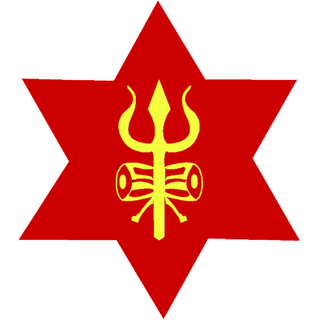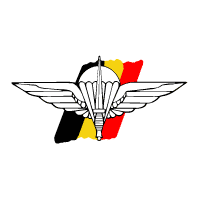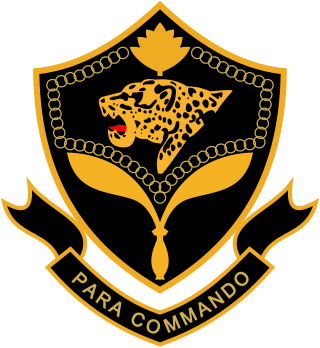
A paratrooper is a military parachutist—someone trained to parachute into a military operation, and usually functioning as part of airborne forces. Military parachutists (troops) and parachutes were first used on a large scale during World War II for troop distribution and transportation. Paratroopers are often used in surprise attacks, to seize strategic objectives such as airfields or bridges.
The Infantry of the British Army comprises 49 infantry battalions, from 19 regiments. Of these, 33 battalions are part of the Regular army and the remaining 16 a part of the Army Reserve. The British Army's Infantry takes on a variety of roles, including armoured, mechanised, air assault and light.

Brigade of Gurkhas is the collective name which refers to all the units in the British Army that are composed of Nepalese Gurkha soldiers. The brigade draws its heritage from Gurkha units that originally served in the British Indian Army prior to Indian independence, and prior to that served for the East India Company. The brigade includes infantry, engineering, signal, logistic and training and support units. They are known for their khukuri, a distinctive heavy knife with a curved blade, and have a reputation for being fierce and brave soldiers.

The United States Army Special Operations Command (Airborne) (USASOC ( YOO-sə-sok)) is the command charged with overseeing the various special operations forces of the United States Army. Headquartered at Fort Liberty, North Carolina, it is the largest component of the United States Special Operations Command. It is an Army Service Component Command. Its mission is to organize, train, educate, man, equip, fund, administer, mobilize, deploy and sustain Army special operations forces to successfully conduct worldwide special operations.

The Indonesian Army is the land branch of the Indonesian National Armed Forces. It has an estimated strength of 300,400 active personnel. The history of the Indonesian Army has its roots in 1945 when the Tentara Keamanan Rakyat (TKR) "People's Security Forces" first emerged as a paramilitary and police corps.

The Parachute Regiment is an airborne and special forces regiment of the Indian Army. It was raised in 1945 as part of the British Indian Army but was disbanded after World War II and was re-raised in 1952 as part of the Indian Army. Currently it consists of fifteen Special Forces, two Territorial Army and one Rashtriya Rifles battalions.

The Romanian Special Operations Forces Command is the special forces command of the Romanian Army formed on 01 March 2018 from the former 6th Special Operations Brigade. The Special Forces Command is headquartered in Târgu Mureș, and it is the structure through which the Chief of the General Staff exercises the control over all Special Forces units.

Para (Special Forces), also known as Para Commandos or Para (SF) Commandos, is a group of special forces battalions of the Parachute Regiment in the Indian Army. These units specialize in various roles including counter-terrorism, hostage rescue, unconventional warfare, special reconnaissance, counter-insurgency and direct action.

The 10th Parachute Brigade, abbreviated as 10 PARA BDE, is an elite division-sized hybrid airborne-marine unit within the Malaysian Army. It is tasked with rapid reaction forces inside or outside the boundaries of Malaysia and serves as the key element of the Malaysian Rapid Deployment Force.

The maroon beret in a military configuration has been an international symbol of airborne forces since the Second World War. It was first officially introduced by the British Army in 1942, at the direction of Major-General Frederick "Boy" Browning, commander of the British 1st Airborne Division. It was first worn by the Parachute Regiment in action in North Africa during November 1942.

The 528th Sustainment Brigade (Airborne), 528th Sustainment Brigade (SO) (A), or 528th SB (SO) (A) was activated on 16 December 2008, as part of the overall United States Army Special Operations Forces logistics transformation. The brigade replaced the Special Operations Support Command (Airborne) (SOSCOM) as combat service support and combat health support unit for all Army Special Operations Command (USASOC) units under the 1st Special Forces Command (Airborne).

The Nepali Army, also referred as the Gorkhali Army, is the land service branch of the Nepali Armed Forces. After the Gorkha Kingdom was founded in 1559, its army was established in 1560, and was accordingly known as the Gorkhali Army. The army later became known as the Royal Nepali Army (RNA) following the Unification of Nepal, when the Gorkha Kingdom expanded its territory to include the whole country, by conquering and annexing the other states in the region, resulting in the establishment of a single united Hindu monarchy over all of Nepal. It was officially renamed simply to the Nepali Army on 28 May 2008, upon the abolition of the 240-year-old Nepalese monarchy, and of the 449-year-old rule of the Shah dynasty, shortly after the Nepalese Civil War.

The Special Operations Regiment is a special operations force of the Land Component of the Belgian Armed Forces. Its headquarters is located in Heverlee. It was known as the Light Brigade until 3 July 2018 when it was renamed and transformed into its current form.

The 1st Battalion, Parachute Regiment, is a battalion of the British Army's Parachute Regiment. Along with various other regiments and corps from across the British Armed Forces, it is part of Special Forces Support Group.

The 3rd Battalion, Parachute Regiment, is a battalion sized formation of the British Army's Parachute Regiment and is a subordinate unit within 16 Air Assault Brigade.

The 50th Parachute Brigade is a brigade-sized formation of the Indian Army. Its main force is formed of battalions of the Parachute Regiment. It consists of 3 Parachute Regiment battalions, supported by units of the Regiment of Artillery, the Corps of Engineers and the Army Medical Corps

The Indonesian Army has formed a large number of infantry battalions since it was formed from provisional militias during the Indonesian National Revolution against the Dutch colonial rule, 1945–1949. Today, the International Institute for Strategic Studies' Military Balance 2007 lists the Army with 2 brigades plus 60 other battalions in the KODAMs, or Military Regional Commands, and nine battalions in KOSTRAD, the Army Strategic Reserve Command. There are also around nine airborne battalions.

The Para-Commando Brigade was an elite force in the Belgian Land Component, consisting of two paracommando battalions, the Special Forces Group and a support unit of the Communication & Information Systems Group (CIS). In 2003, its name was changed to the Light Brigade. On 3 July 2018, the Light Brigade was renamed and transformed into the Special Operations Regiment.

The Para Commando Brigade is a special operations force of the Bangladesh Army. This special forces brigade is headquartered at Jalalabad Cantonment, Sylhet. It is composed of two para commando battalions.















